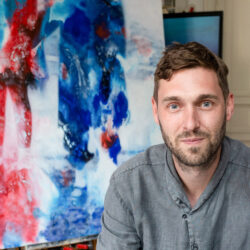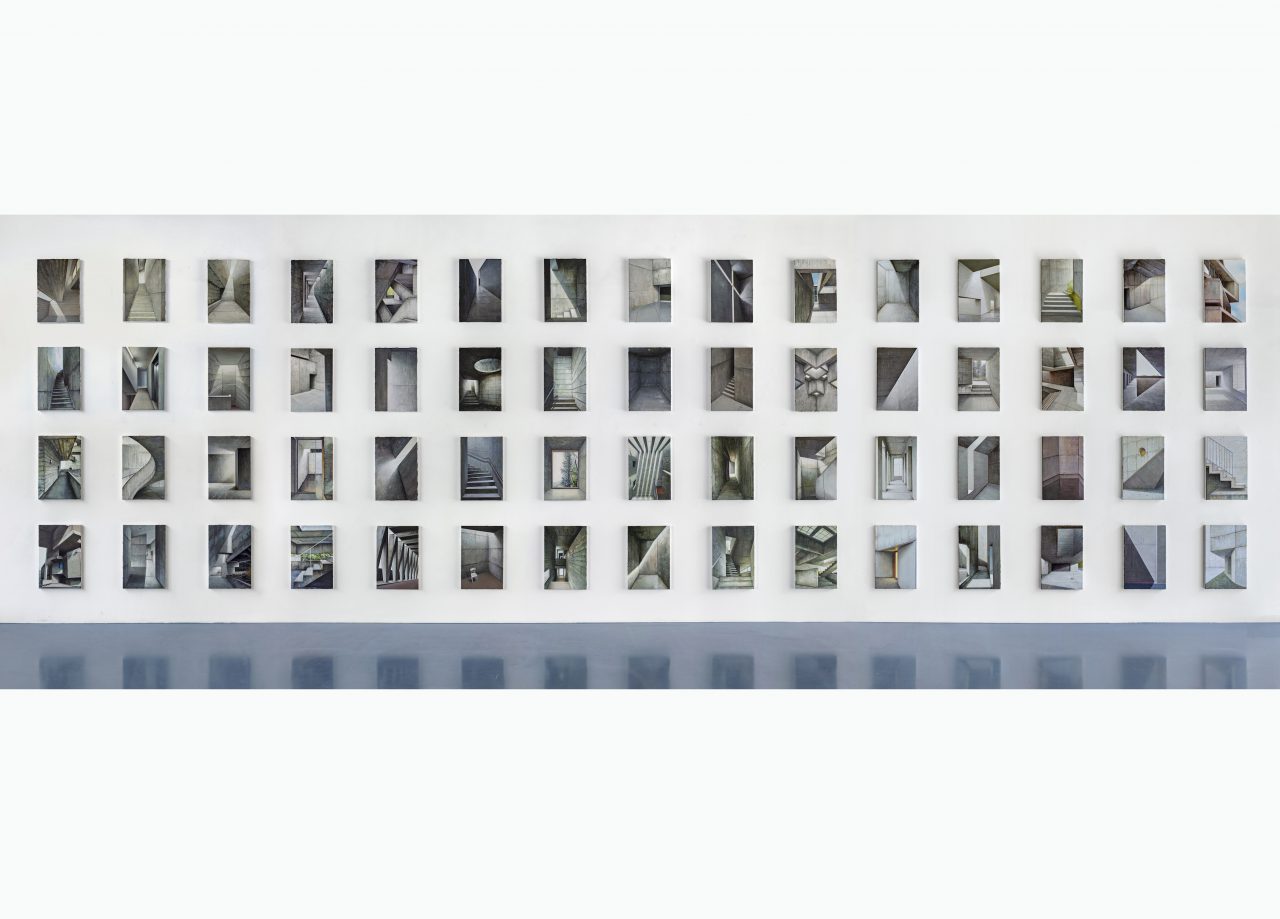
JANN HOLSTEIN
...Page is loading...

Babel / 60 fragments - 300 x 1500cm - 2017 / 19
Germany
Remarks on the Works by Jens Hausmann
Christoph Tannert
Jens Hausmann paints, draws, and makes collages. In every of these artistic practices, he has discovered a truth for himself. And yet, these partial systems, mutually stimulating each other, come together into one work.
With his drawings and collages (with painterly elements), Hausmann set vitalizing marks. In relation to this, every large format in the...
Remarks on the Works by Jens Hausmann
Christoph Tannert
Jens Hausmann paints, draws, and makes collages. In every of these artistic practices, he has discovered a truth for himself. And yet, these partial systems, mutually stimulating each other, come together into one work.
With his drawings and collages (with painterly elements), Hausmann set vitalizing marks. In relation to this, every large format in the stretch frame scores like an expanding field of action.
While in Hausmann’s current paintings there are no figures anymore, the works on paper are full of figures and figurative scenes. As if his visual cast felt more comfortable in a more intimate format. For his collages, Hausmann frequently uses newspaper photographs. He attacks the photographic perspective with scissors and whiteout. He works the photographs over with a marker, and places new emphases. The artist defines his drawings, executed with ballpoint pens, felt-tip pens, and pencil, more as playing fields, emphasizing interior structures and the relationship between plains. We can distinguish here between sketched narrative situations (e.g., Selfie, Sonnenbad, Müll) and architectural sketches (e.g., Shoppingcenter 1- 4, Klaus Staeck-Haus). The water-colored drawings occupy an intermediate position. One the one hand, they stand alone, on the other hand, they were also made as sketches for oil paintings. (see Verlust, Waiting). In this way, Hausmann has truths and aesthetic values enter into a dialogue.
However, the painter Jens Hausmann’s great subject remains painting as such. He is interested in the representational relationships between nature and culture, architecture and landscape. His paintings have titles like The Garden, The Place, or Modern House. We are taken to places we have dreamt of, places we have desired, stylish places, which on the soul’s night side, however, seem traumatic, cursed, dangerous. Hausmann is driven by philosophical fantasies. Fiction, reality: you never now absolutely without doubt what that is, he says.
In the same breath, the works make us more keenly aware of the botanical in Hausmann’s work: his fascination for the cyclical is ardent in his celebration of growth, flowering, and wilting of vegetation.
In Hausmann’s paintings, the motif walls itself in between the stretcher frame and turns its dark gray building walls with their razor-sharp edges towards our life. We see hibernation architecture in an exuberantly growing nature, leading to a longing for an interior hiding place. This interior space can be a protective space, but also a trap. Hausmann’s play with the relationship between interior and exterior touches as much on the stylistic as on the claustrophobic.
Stylishness and cleanliness in art and architecture are, well, problematic. Modernism has crammed people too autocratically into its deserts drawn up on the drawing board. And art, far too self-sufficient, settled down in the white cube, in the neutrally white gallery like in an ivory tower. For the aesthetics of the twentieth century, the neutral gray of concrete was not a color, it represented an ideology. It stood for the rule of pure ideas and utopias. But in the end, the non-ornamented world had acquired the reputation in art and in architecture of cutting things off from their environment, and from contradictions as well as from nuances.
Jens Hausmann paints for us his version of buildings in an emotionally arctic modernism, which is slowly reconquered by nature.
The sophisticated beauty of constructivism, whose immaculate elegance was set against nature, is no longer in a dominating position.
The buildings remain almost aggressively silent towards the world, massive, hostile, withdrawn. The leafage behind them, striving towards the light, on the other hand, follow the principle of openness, is wild, chaotic, and indomitable.
The interior of the piles of concrete, behind walls that are several meters thick, is the site of modernist representation. Outside, the freedom of plant growth dominates, which even stands up to the poisons man attacks it with.
We understand that modernism, indiscriminately rammed into the landscape, can look beautiful. But at the same time, it is a dead end. Thus the score is 1:0 for nature.
Hausmann reflects modernism in the catacombs of world-denial protected by power. He does so with a contemporary painterly stance that looks after itself in an outstanding way, without losing sight of the world (and that also means the world of the painting).
Hausmann practices a painterly culture. His painted surfaces are thoroughly worked through, and alive. Through the way he treats paint, he allows us to feel the world. They are grand gestures that turn the material into an event—thus making the subject all the more urgent. Because Hausmann chooses a position of the in-between. His forms are simultaneously abstract and concrete, figurative and non-figurative. With great visual effects, he maneuvers us between the poles of absolutely cerebral and the painterly materiality. The uncomplicated and the artificial come together to form an energetic mixture that charges every painting like a battery.
A phenomenon that I noticed is from the field of film. .But to avoid any misunderstanding, I would like to make clear that Hausmann does not illustrate films. Rather, his paintings are aesthetically inspired by his experience of film, and certain effects with respect to the direction of light and spatial design. Early film sequences in his works on paper from 1995 attest to this interest.
True fear, as Alfred Hitchcock knew, grows in the beholder’s mind. If you only hint at something terrible, you give the imagination an opportunity to really run wild, and to create something much worse than what a director could do. This realization could also be applied to Jens Hausmann’s current paintings.
This artist subtly uses a quiet horror that goes deep, and maltreats the beholder with subcutaneous terror.
Jens Hausmann’s paintings don’t just tell of a great passion for film, they also translate this passion into a different and rather fascinating language.
This painter opens doors to the unconscious. In his stagings (that could also be films in the mind), he uncovers something that is hidden in ourselves—an entrance to something that has hitherto not been thought.
The realities that Jens Hausmann seeks to decipher, however, don’t lead into irrationality—rather, they make sense. They do so because they are contained in a rigorous staggering of comprehensible factualities.
Jens Hausmann is somebody one enjoys meeting, because he is so enthusiastic, and his enthusiasm is infectious. Because although he doesn’t believe in happy ends, he exudes unbelievable trust in the power of words and images.
In his finest moments, he creates the visual tension that Alfred Hitchcock called “suspense.”
Such paintings, painted with delicacy and refinement, are designed to thoroughly confuse our emotional equilibrium. While we behold a painting, it is quite possible that our own skin will feel hot and cold at the same time, like a heavenly purgatory.
Translated by Wilhelm Werthern, www.zweisprachkunst.de
2020
THE PROMISED LAND / KOGAN AMARO GALERIA / SAO PAULO / BR (Katalog)
RAUM UND HÜLLE / GALERIE MARTIN MERTENS / BERLIN
BABEL / 60 FRAGMENTS / MUSEO FABRICA DE ARTE MARCOS AMARO / SAO PAULO / BR (Katalog)
show all
2020
CONSTRUCT YOUR STORYS / AUSSTELLUNG ZUM FALCKENROTPREIS / KÜNSTLERHAUS BETHANIEN / BERLIN
2019
RHIZOME / BERLIN BASED / FRANK TAAL GALERIE / ROTTERDAM / NL (kuratiert von Bram Braam)
2018
NGORONGORO, II / ARTIST WEEKEND / BERLIN
show all
Fondation Marcus Amaro / Sao Paulo
Museum der bildenden Künste Leipzig
Sammlung Krings Ernst / Köln
GALERIE MARTIN MERTENS / BERLIN
GALERIE ANJA KNOESS / KÖLN
KOGAN AMARO GALERIA / SAO PAULO / ZÜRICH